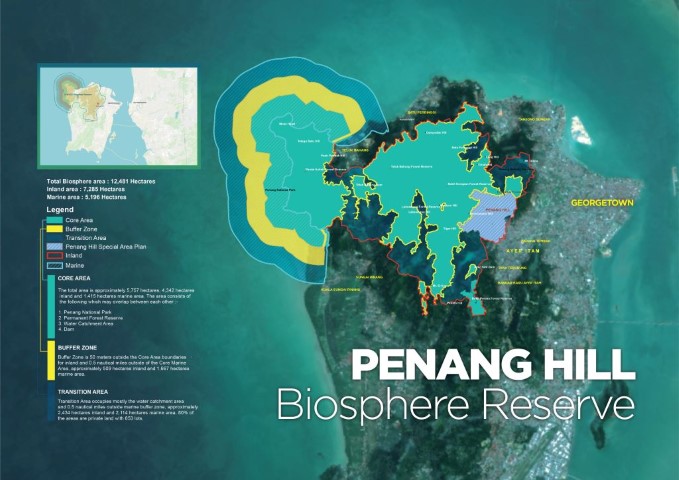Ecosystem
Penang Hill Biosphere Reserve
Ecosystem
An ecosystem is an interaction of an ecological community consisting of plants, animals, fungi, bacteria, viruses, protists, and other microorganisms living together in a particular habitat.
Each environmental factor in an ecosystem relies on the climate, humidity level, and soil moisture content.
The Penang Hill Biosphere Reserve is home to diverse ecosystems, each with unique flora and fauna species.
Some of the foremost ecosystems that can be distinguished within the biosphere reserve include terrestrial and marine ecosystems and the unique flora and fauna ecosystems within Penang Hill Biosphere Reserve.
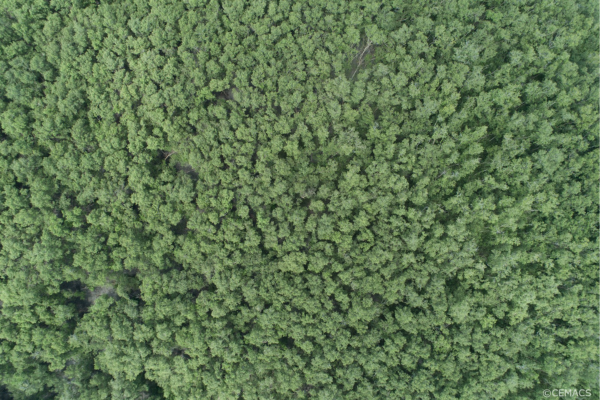
Terrestrial

Terrestrial ecosystems are predominantly characterized by the soils covering their surfaces.
The land-based ecosystem includes various types, such as deserts, grasslands, tropical forests, and temperate deciduous forests.
The Penang Hill Biosphere Reserve (PHBR) covers a land surface of 7,285 hectares and includes four distinguished forest types:
Lowland Dipterocarp Forest,
Hill Dipterocarp Forest,
Upper Dipterocarp Forest, and Mangrove Forest.
The differences between the Lowland Dipterocarp Forest, Hill Dipterocarp Forest, and Upper Dipterocarp Forest are mainly due to the climate in each of these forests.
As you move from the lowlands to the highlands, the temperature is expected to decrease by 6.5 °C for every 1000 meters in altitude change.
Lowland Forest
Lowland Dipterocarp Forest
Lowland Dipterocarp Forest develops from elevations ranging from sea level 0 to below 300 meters.
In Peninsular Malaysia, the lower montane forest is the most developed and distinct forest formation found in the lowland areas.
The mean temperature ranges from 20 °C to 34 °C, with uniform precipitation all year round, total rainfall over 2000 millimeters, and no distinct dry season.
Lowland dipterocarp forests often contain many Dipterocarpaceae family species (big trees), such as Anisoptera spp., Dipterocarpus spp., Dryobalanops spp., Hopea spp., Parashorea spp., Shorea spp.
The common species are Dyera costulata (Apocynaceae), Glutta spp. (Anacardiaceae), Heritiera spp. (Malvaceae), Insia palembanica (Leguminosae), Koompassia malaccensis (Leguminosae), Palaquium spp. (Sapotaceae) and Sindora spp. (Leguminosae).
Hill Forest
Hill Dipterocarp Forest
The Hill Dipterocarp Forest ranges from 300 meters to 800 meters above sea level.
Many common Lowland Dipterocarp Forest species can also be found in Hill Dipterocarp Forests.
However, certain species begin to disappear and are replaced by others.
Shorea curtisii is the most common and dominant tree species found in the Hill Dipterocarp Forest, growing in association with the understorey palm Eugeissona tristis.
Mountain Forest
Upper Dipterocarp Forest
The Upper Dipterocarp Forest ranges from 800 to 1,200 meters above sea level.
The highest peak, Western Hill, stands at 833 meters (2,733 ft) above sea level, making it the maximum elevation for the PHBR on Penang Hill.
Agathis borneensis (Araucariaceae) and Shorea platyclados are the most dominant species in this forest type.
The Agathis borneensis species exhibit strong distribution patterns in the Penang Hill forest areas.
Mangrove Forest

Mangroves are woody trees with a thick, partially exposed root network that grows down from the branches into the water and sediment.
These trees grow along sheltered coastlines in tropical and subtropical areas.
Mangroves are salt-tolerant forest ecosystems that are able to withstand tidal areas of seawater, strong winds, high temperatures, and muddy soils.
Mangrove swamps are divided into various zones using the dominant trees as a means of zoning.
In general, two types of zonation can be observed:
1. From a sheltered tidal area to the beach forest area, the following zones are distinguishable:
The Sonneratia zone: Sonneratia species are among the pioneering species of a mangrove swamp. On the shores, Sonneratia alba is commonly found on the seaward side of the mangroves.
The Rhizophora zone: Rhizophora forests develop behind the salt-tolerant pioneering species, R. mucronata, with R. apiculata occurring behind a seaward fringe.
The Bruguiera zone: Bruguiera forests usually develop behind the Rhizophora species on better drained soils.
The Ceriops zone: Ceriops develop where there is intermediate rainfall and good drainage.
Mixed zone: This category represents the most variable zone with different species occurring depending on the soil type present. Species such as Heritiera littoralis, Lumnitzera littorea, Camptostemon schultzii, Cynometra ramiflora, and others may occur in this zone.
The Nypa zone: Nypa fruticans grow in areas along tidal streams that are flooded during high tide and thrive in brackish water.
2. From the open sea to the beach forest area, the following zonation can be observed:
The Avicennia zone: Like the Sonneratia species, Avicennia species are the pioneers of the mangrove swamp. A. marina predominantly colonizes the fringe of the swamp, while A. alba grows more along the channels. A. eucalyptifolia is commonly found in the vicinity of coral reefs or offshore coral islands.
The Mixed zone: In this zone, species like Heritiera littoralis, Excoecaria agallocha, Xylocarpus granatum, and Osbornia octodonta may occur.
Coastal & Marine
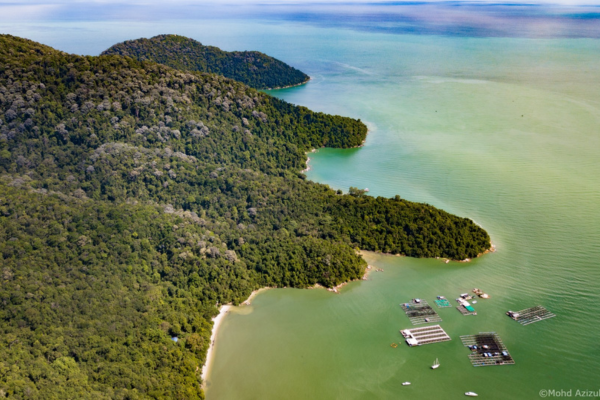
While the Penang Hill Biosphere Reserve is primarily a rainforest ecosystem, it also includes a coastal and marine ecosystem crucial for conserving marine biodiversity.
The coastal and marine ecosystem of the biosphere reserve is situated along the northern coast of Penang Island. It encompasses several important habitats, such as mangrove forests, seagrass beds, and coral reefs.
It covers 5,196 hectares of marine ecosystems surrounding the Penang National Park.
The PHBR marine ecosystem is home to abundant diversity, with many types of seafood of high commercial value, including bivalves, mollusks, and fish.
The marine ecosystem near the Strait of Malacca is a biodiversity hotspot due to its abundant marine species diversity.
Mangrove forests are important ecosystems that provide a range of benefits, including shoreline protection, carbon storage, and habitats for fish and other marine species.
The mangrove forests in the Penang Hill Biosphere Reserve are home to a diverse range of species, including several species of birds, crabs, and fish.
Seagrass beds are another important component of the coastal and marine ecosystem of the biosphere reserve. These habitats are home to a diverse range of marine life, including fish, sea turtles, and seahorses.
They also play an important role in the ecosystem by providing food and habitat for many species.
Coral reefs are one of the most biodiverse ecosystems on the planet and are home to a wide range of marine species.
The coral reefs in the Penang Hill Biosphere Reserve are part of the Coral Triangle, which is renowned for its high levels of marine biodiversity.
These reefs are home to a diverse range of species, including fish, sharks, and turtles.
The coastal and marine ecosystem of the Penang Hill Biosphere Reserve is under threat from a range of factors, including pollution, overfishing, and climate change.
Conservation efforts are underway to protect these important habitats and the species that depend on them.
These efforts include the establishment of marine protected areas, the promotion of sustainable fishing practices, and the implementation of measures to reduce pollution and mitigate the impacts of climate change.
One of the primary goals of the PHBR is to safeguard the coastal and marine ecosystem of the biosphere reserve, ensuring the preservation of these vital habitats and the species reliant upon them.
Biodiversity
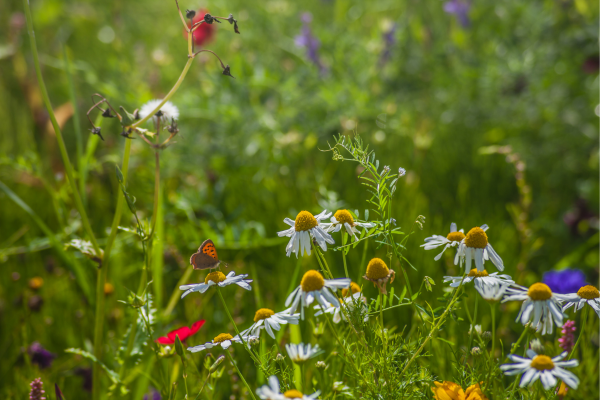
The Penang Hill Biosphere Reserve is renowned for its high biodiversity, encompassing a large number of plant and animal species within its diverse ecosystems. It is a significant asset, contributing to the area’s ecological and economic value. Some key features of the biosphere reserve’s biodiversity include:
Flora: The biosphere reserve is home to over 2,000 plant species, including many endemic and rare species. Some notable plant species within the reserve include the giant bamboo.
Fauna: The biosphere reserve is also home to various animal species, including over 100 bird species, ten reptile species, and 11 mammal species. Some notable animal species in the reserve include the black giant squirrel (Ratufa bicolor), dusky leaf langur (Trachypithecus obscurus) and greater racket-tailed drongo (Dicrurus paradiseus)
Endemic Species:
The Penang Hill Biosphere Reserve is home to several endemic species, which means they are found nowhere else in the world. Some notable endemic species in the reserve include the dusky leaf langur (Trachypithecus obscurus) and the spiny turtle testudines (Heosemys spinosa)
Threatened Species:
Some of these threatened animals include sea turtles and dolphins, the Sunda Pangolin (Manis javanica), the Sunda Slow Loris (Nycticebus coucang), and the Dusky Leaf Langur (Trachypithecus obscurus)
The high level of biodiversity also highlights the importance of conservation efforts to protect these species and their habitats.
Penang Hill Biosphere Reserve
Ecosystem
An ecosystem is an interaction of an ecological community consisting of plants, animals, fungi, bacteria, viruses, protists, and other microorganisms living together in a particular habitat.

Each environmental factor in an ecosystem relies on the climate, humidity level, and soil moisture content.
The Penang Hill Biosphere Reserve is home to diverse ecosystems, each with unique flora and fauna species.
Some of the foremost ecosystems that can be distinguished within the biosphere reserve include terrestrial and marine ecosystems and the unique flora and fauna ecosystems within Penang Hill Biosphere Reserve.
Terrestrial

Terrestrial ecosystems are predominantly characterized by the soils covering their surfaces.
The land-based ecosystem includes various types, such as deserts, grasslands, tropical forests, and temperate deciduous forests.
The Penang Hill Biosphere Reserve (PHBR) covers a land surface of 7,285 hectares and includes four distinguished forest types:
- Lowland Dipterocarp Forest
- Hill Dipterocarp Forest
- Upper Dipterocarp Forest
- Mangrove Forest
The differences between the Lowland Dipterocarp Forest, Hill Dipterocarp Forest, and Upper Dipterocarp Forest are mainly due to the climate in each of these forests.
As you move from the lowlands to the highlands, the temperature is expected to decrease by 6.5°C for every 1000 meters in altitude change.
Lowland Forest
Lowland Dipterocarp Forest
Lowland Dipterocarp Forest develops from elevations ranging from sea level 0 to below 300 meters.
In Peninsular Malaysia, the lower montane forest is the most developed and distinct forest formation found in the lowland areas.
The mean temperature ranges from 20°C to 34°C, with uniform precipitation all year round, total rainfall over 2000 millimeters, and no distinct dry season.
Lowland dipterocarp forests often contain many Dipterocarpaceae family species (big trees), such as Anisoptera spp., Dipterocarpus spp., Dryobalanops spp., Hopea spp., Parashorea spp., Shorea spp.
The common species are Dyera costulata (Apocynaceae), Glutta spp. (Anacardiaceae), Heritiera spp. (Malvaceae), Insia palembanica (Leguminosae), Koompassia malaccensis (Leguminosae), Palaquium spp. (Sapotaceae) and Sindora spp. (Leguminosae).
Hill Forest
Hill Dipterocarp Forest
The Hill Dipterocarp Forest ranges from 300 meters to 800 meters above sea level.
Many common Lowland Dipterocarp Forest species can also be found in Hill Dipterocarp Forests.
However, certain species begin to disappear and are replaced by others.
Shorea curtisii is the most common and dominant tree species found in the Hill Dipterocarp Forest, growing in association with the understorey palm Eugeissona tristis.
Mountain Forest
Upper Dipterocarp Forest
The Upper Dipterocarp Forest ranges from 800 to 1,200 meters above sea level.
The highest peak, Western Hill, stands at 833 meters (2,733 ft) above sea level, making it the maximum elevation for the Penang Hill Biosphere Reserve on Penang Hill.
Agathis borneensis (Araucariaceae) and Shorea platyclados are the most dominant species in this forest type.
The Agathis borneensis species exhibit strong distribution patterns in the Penang Hill forest areas.
Mangrove Forest

Coastal and Marine
Mangroves are woody trees with a thick, partially exposed root network that grows down from the branches into the water and sediment.
These trees grow along sheltered coastlines in tropical and subtropical areas.
Mangroves are salt-tolerant forest ecosystems that are able to withstand tidal areas of seawater, strong winds, high temperatures, and muddy soils.
Mangrove swamps are divided into various zones using the dominant trees as a means of zoning.
In general, two types of zonation can be observed:
1. From a sheltered tidal area to the beach forest area, the following zones are distinguishable:
The Sonneratia zone: Sonneratia species are among the pioneering species of a mangrove swamp. On the shores, Sonneratia alba is commonly found on the seaward side of the mangroves.
The Rhizophora zone: Rhizophora forests develop behind the salt-tolerant pioneering species, R. mucronata, with R. apiculata occurring behind a seaward fringe.
The Bruguiera zone: Bruguiera forests usually develop behind the Rhizophora species on better drained soils.
The Ceriops zone: Ceriops develop where there is intermediate rainfall and good drainage.
Mixed zone: This category represents the most variable zone with different species occurring depending on the soil type present. Species such as Heritiera littoralis, Lumnitzera littorea, Camptostemon schultzii, Cynometra ramiflora, and others may occur in this zone.
The Nypa zone: Nypa fruticans grow in areas along tidal streams that are flooded during high tide and thrive in brackish water.
2. From the open sea to the beach forest area, the following zonation can be observed:
The Avicennia zone: Like the Sonneratia species, Avicennia species are the pioneers of the mangrove swamp. A. marina predominantly colonizes the fringe of the swamp, while A. alba grows more along the channels. A. eucalyptifolia is commonly found in the vicinity of coral reefs or offshore coral islands.
The Mixed zone: In this zone, species like Heritiera littoralis, Excoecaria agallocha, Xylocarpus granatum, and Osbornia octodonta may occur.

While the Penang Hill Biosphere Reserve is primarily a rainforest ecosystem, it also includes coastal and marine ecosystems that are crucial for conserving marine biodiversity.
The coastal and marine ecosystems of the biosphere reserve is situated along the northern coast of Penang Island. It encompasses several important habitats, such as mangrove forests, seagrass beds, and coral reefs.
It covers 5,196 hectares of the marine ecosystem surrounding the Penang National Park.
The Penang Hill Biosphere Reserve’s marine ecosystem is home to abundant diversity, with many types of seafood of high commercial value, including bivalves, mollusks, and fish.
The marine ecosystem near the Strait of Malacca is a biodiversity hotspot due to its abundant marine species diversity.
Mangrove forests are important ecosystems that provide a range of benefits, including shoreline protection, carbon storage, and habitats for fish and other marine species.
The mangrove forests in the Penang Hill Biosphere Reserve are home to a diverse range of species, including several species of birds, crabs, and fishes.
Seagrass beds are another important component of the coastal and marine ecosystem of the biosphere reserve. These habitats are home to a diverse range of marine life, including fishes, sea turtles and seahorses.
They also play an important role in the ecosystem by providing food and habitat for many species.
Coral reefs are one of the most biodiverse ecosystems on the planet and are home to a wide range of marine species.
The coral reefs in the Penang Hill Biosphere Reserve are part of the Coral Triangle, which is renowned for its high levels of marine biodiversity.
These reefs are home to a diverse range of species, including fish, sharks, and turtles.
The coastal and marine ecosystems of the Penang Hill Biosphere Reserve is under threat from a range of factors, including pollution, overfishing, and climate change.
Conservation efforts are underway to protect these important habitats and the species that depend on them.
These efforts include the establishment of marine protected areas, the promotion of sustainable fishing practices, and the implementation of measures to reduce pollution and mitigate the impacts of climate change.
One of the primary goals of the Penang Hill Biosphere Reserve is to safeguard the coastal and marine ecosystems of the biosphere reserve, ensuring the preservation of these vital habitats and the species reliant upon them.
Biodiversity

The Penang Hill Biosphere Reserve is renowned for its high biodiversity, encompassing a large number of plant and animal species within its diverse ecosystems. It is a significant asset, contributing to the area’s ecological and economic value. Some key features of the biosphere reserve’s biodiversity include:
Flora: The biosphere reserve is home to over 2,000 plant species, including many endemic and rare species. Some notable plant species within the reserve include the giant bamboo.
Fauna: The biosphere reserve is also home to various animal species, which include birds, reptiles and mammals. Some notable animal species in the reserve include the black giant squirrel (Ratufa bicolor), dusky leaf langur (Trachypithecus obscurus) and greater racket-tailed drongo (Dicrurus paradiseus).
Endangered Species: The Penang Hill Biosphere Reserve is home to several endangered species, which means they are found nowhere else in the world. Some notable endangered species in the reserve include the dusky leaf langur (Trachypithecus obscurus) and the spiny turtle testudines (Heosemys spinosa).
Threatened Species: Some of these threatened animals include sea turtles and dolphins, the Sunda Pangolin (Manis javanica) and the Sunda Slow Loris (Nycticebus coucang).
The high level of biodiversity also highlights the importance of conservation efforts to protect these species and their habitats.
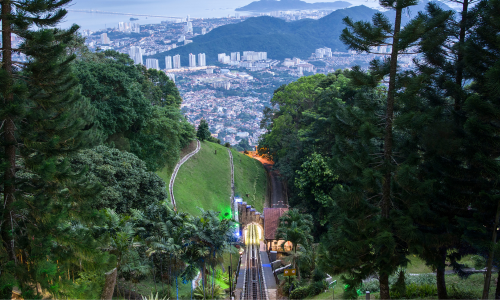
Tourist Attractions

Gallery

Partners
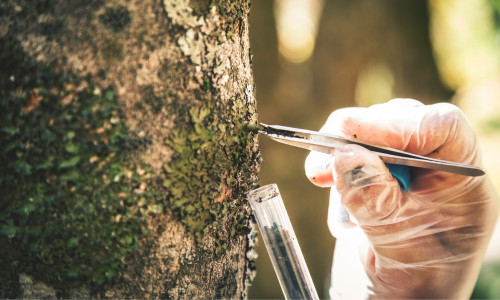
Programmes

Projects
